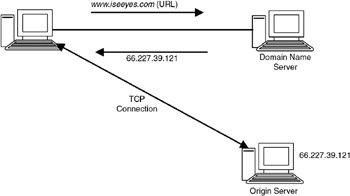24.3 DOMAIN NAME SYSTEM
|
| < Day Day Up > |
|
24.3 DOMAIN NAME SYSTEM
To identify the computers on the Internet, a 32-bit IP address is assigned to each computer. To identify computers by an address of this format is not user friendly—an easy to remember, easy to pronounce name would be a better choice. Domain Name System (DNS) provides this facility. However, this naming system should be universal—a computer on the Internet should be uniquely identified by the name, and there should be unique mapping between the name and the IP address.
To have one central authority to assign names becomes a complex task. Therefore, a hierarchical naming scheme has been devised.
Assigning a naming scheme is analogous to the telephone numbering scheme. At the highest level, each country is assigned a country code (which is done centrally). Within the country, each region is assigned a code, and this assignment is done by a central authority in the respective countries. Within each region, the numbering scheme is decentralized.
The Domain Name System facilitates translation of a user-friendly address (such as http://www.iseeyes.com) to the IP address. Domain name servers provide this facility. A hierarchical naming scheme is used to assign domain names. The top-level domain name can reflect the name of the country or the type of organization.
On the Internet, a typical domain name can be:
cs.jntu.edu
where edu is the top-level domain name, cs.jntu.edu is the secondary domain, and cs.jntu.edu is the tertiary domain. The top-level domain names have to follow a standard specified by the International Organization for Standardization (ISO). Some of the accepted top-level domain names are:
| com | commercial organizations |
| biz | commercial organizations |
| edu | educational institutions |
| net | major network support centers/commercial organizations |
| org | non-profit organizations |
| gov | government organizations |
| mil | military organizations |
| name | individuals |
In addition, the top-level domain names can denote the name of the country:
| us | United States of America |
| in | India |
| uk | United Kingdom |
| tw | Taiwan |
| sg | Singapore |
| de | Germany |
| Note | Some top-level domain names have been introduced recently. These include .biz, .name, and .tv. If you want to have your own URL, you can check its availability at the site http://www.register.com. |
24.3.1 Domain Name Servers
The server that does the translation between the domain name and the corresponding IP address is called the domain name server. The client runs name resolution software to obtain an IP address. There are two ways for name resolution:
-
Recursive resolution
-
Nonrecursive resolution or iterative resolution
In recursive resolution, if a name server cannot resolve the IP address of a name, it will contact another name server and obtain the information, which will be sent to the client. In nonrecursive or iterative resolution, if the name server cannot resolve the address, it will send a message to the client, giving information as to which name server to contact for obtaining the IP address.
Figure 24.3 illustrates how the URL is translated to an IP address. When the user logs in to the ISP's network access server through a dial-up connection, a temporary IP address is given to his computer (known as the dynamic IP address). This address is given by the ISP server from a pool of dynamic IP addresses. The user invokes a browser and gives a URL. This URL is sent to the domain name server. The domain name server obtains the IP address and sends it to the user's application. The application will establish a TCP connection (through the IP layer) with the origin server in which the resource corresponding to the URL is located. Then the origin server sends the HTML page corresponding to the URL.

Figure 24.3: URL translation to IP address.
When you get connected to the Internet, you are assigned a temporary IP address called the Dynamic IP address. This IP address is given by the ISP server. When you access a URL, the IP address of the Origin Server is obtained by the Domain Name Server using recursive resolution or iterative resolution.
Once a TCP connection is established between the client and the origin server, the packets are exchanged between the client and the server, using the TCP/IP protocol. The routing algorithms discussed in Chapter 21, "Internet Protocol (IP)" are used to route the packets.
| Note | The resource corresponding to a URL is a Web page written in HTML. The HTML file is a text file containing tags. This HTML file is downloaded on to the client's computer. The browser, such as Internet Explorer, interprets this HTML file and presents the content to the user. |
|
| < Day Day Up > |
|
EAN: 2147483647
Pages: 313